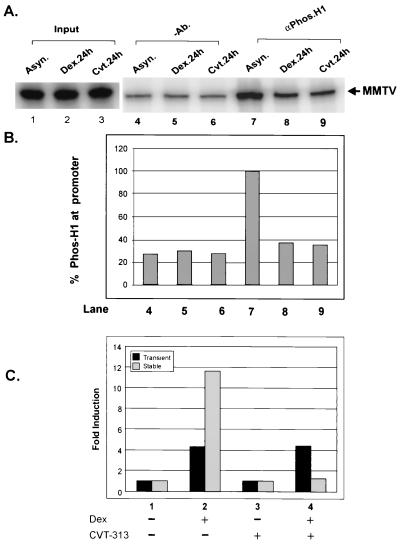FIG. 6.
CVT-313 reduces phosphorylation of histone H1 at the MMTV promoter in vivo but does not inhibit GR activation of a transiently transfected MMTV reporter. (A) Loss of phosphorylated H1 at the MMTV promoter upon prolonged treatment with hormone and CVT-313. Cells were untreated (lanes 1, 4, and 7), treated with dexamethasone (10−7 M) for 24 h (lanes 2, 5, and 8), or treated with CVT-313 (25μM) for 24 h (lanes 3, 6, and 9). The cells were fixed by adding formaldehyde (37%) directly to the medium (1:100) for 10 min. Nuclei were then isolated and digested completely with HaeIII. Digested nuclei were immunoprecipitated without (lanes 4 to 6) or with (lanes 7 to 9) an antibody specific for phosphorylated histone H1. Input (lanes 1 to 3) and immunoprecipitated DNA (lanes 4 to 9) was purified as described previously, and nucleosome B sequences within the MMTV promoter were detected by PCR amplification (26). (B) PCR products were analyzed using 8% polyacrylamide denaturing gels and quantified by use of a PhosphorImager using ImageQuant software. (C) CVT-313 does not block GR activation from a transiently transfected reporter. Cells were left untreated (column 1), treated with dexamethasone (Dex) for 8 h (column 2), treated with CVT-313 for 24 h (column 3), or treated with CVT-313 for 24 h followed by the addition of dexamethasone for 8 h (column 4). Lysates were prepared and assayed for luciferase and CAT activity from transient and stable constructs, respectively. Induction of MMTV luciferase and CAT activity is indicated as the fold induction relative to untreated cells.

